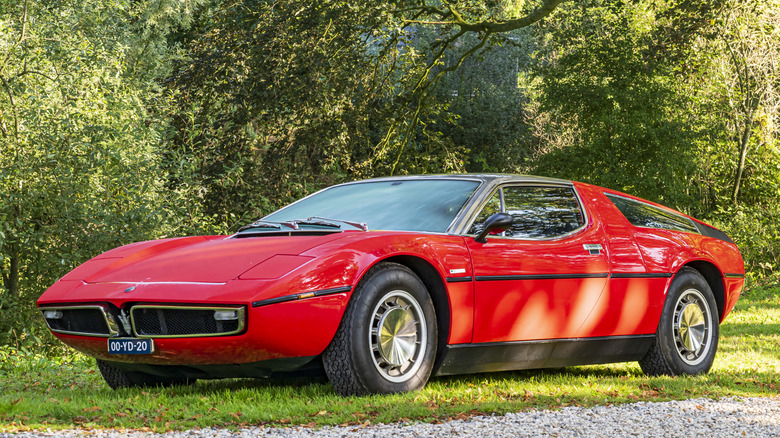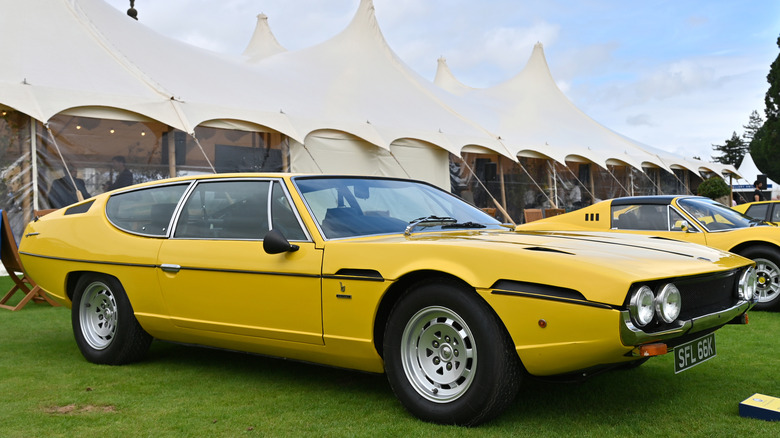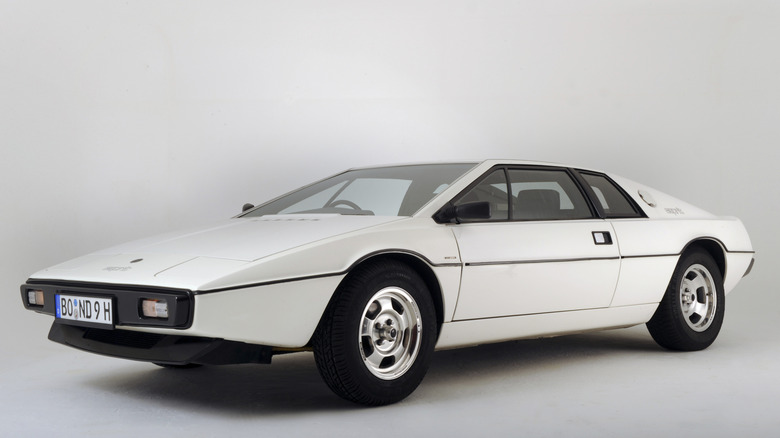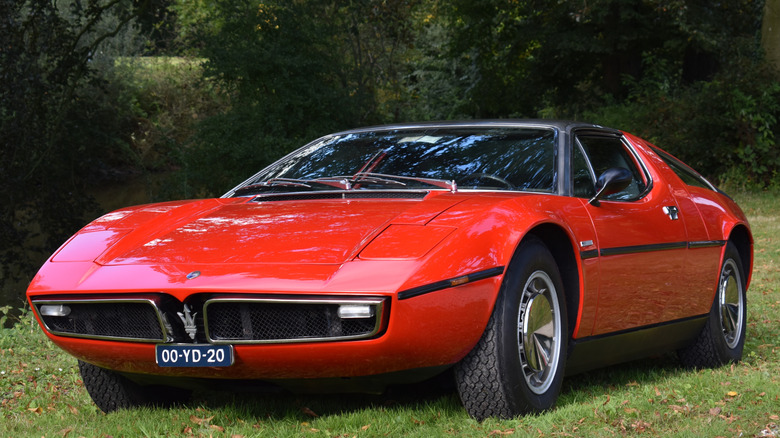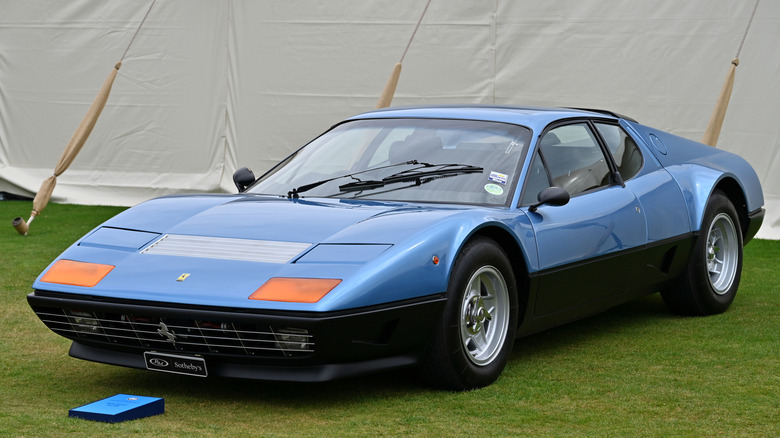5 Out-Of-Sight Supercars From The 1970s
Prior to the 1970s, the concept of the supercar had only been around for three years since the introduction of Lamborghini's game-changing Miura. The Miura was exceptionally fast, advanced, and pretty, and this new class of car had yet to be explored by the majority of the world's finest automotive engineers. The 1970s proved to be a decade of experimentation. Many well-known brands tried a hand at building a supercar, emulating what they saw in the Miura, whether it was its mid-engined layout, low, sleek design, or V12 heart. The race had begun, and the creations that followed ranged from legendary to forgettable.
Many cars from this era are considered classics today, such as the Lancia Stratos, the BMW M1, and the Lamborghini Countach. The stars of this era are looked upon affectionately for defining what this new class of car could be and for opening the doors for future creations. This immense reverence for the stars of the time was so great, though, that many other supercars were shortchanged of the recognition they deserved. There are cars just as good as their more famous counterparts on paper, but just never seemed to ping the radars of the masses. Here are five out-of-sight supercars from the 1970s.
Lamborghini Espada
Thinking of Lamborghini before the turn of the century evokes famous models like the Diablo, Miura, and Countach. The overarching image is a two-door, wedge-shaped blade on wheels rocketing through the Italian countryside, perhaps not as fast as some other competitors, but certainly with more style. In 1970, the Lamborghini Urus was still nearly 50 years away from its 2017 introduction, and the thought of a four-door Lamborghini was unheard of. However, Ferruccio Lamborghini had a vision for a car bearing his name that could carry not two but four, in the style and at the speeds for which his creations were known.
The result of this vision was the Lamborghini Espada. The Espada was a four-door, four-seater super GT, but it was still very much a Lamborghini. Designed by Bertone, it was low-slung and slim, with a long wheelbase to fit its passengers and its engine. The engine in question was a 4-liter naturally aspirated V12 that produced 320 horsepower, which propelled the Espada to a top speed of around 155 mph. It was a more than capable car, but the nature of its layout made it an unlikely choice for those looking for the supercar experience, making it an underrated member of the Lamborghini clan. The interest in a super-fast four-seater simply wasn't there as it is today, and more traditional competitors outshone the Espada despite its good looks and abilities.
De Tomaso Pantera
Although De Tomaso has made a comeback in recent years with its hyper-beautiful and hyper-expensive P72 supercar, the Italian automaker has never reached the heights of its fellow countrymen like Ferrari and Lamborghini. Founded in 1959, De Tomaso has produced a catalogue of cars largely unbeknownst to most consumers, with even its most famous model, the Pantera, left in the shadows when compared to its contemporaries. This is not a dig on the Pantera, though, because to this day it remains a supremely cool car.
De Tomaso collaborated with Ford, using it to source the American-made 330 hp V8 that would power the Pantera from its mid-mounted position. The outsourcing of the engine left De Tomaso the freedom and resources to do what they were really focused on — making a gorgeous car. The Pantera is a product of its time in the best way possible. It has the classic sharp-wedge silhouette of all the 1970s greats, complete with tight angles and creases. It's small, but it retains its presence with assertive design flourishes like quad exhaust pipes. Its accolades should have been enough to launch it to the stratosphere, but competition was stiff. It didn't help that De Tomaso was simply not at the level of household recognition compared to names like Ferrari and Lamborghini, which further alienated the Pantera from the leaders of the pack. This left the Pantera flying under the radar, regardless of its modern desirability.
Lotus Esprit
The Lotus Esprit's biggest claim to fame may be its appearance in the James Bond film, "The Spy Who Loved Me." For a hungry Hollywood actor, being recognized for a role is the dream, but for a lightweight sports car trying to put Lotus on the map for car enthusiasts rather than on the screen for moviegoers, fame of this sort is more disappointing than exciting. Although Lotus was dominating in Formula One with four constructors' and drivers' championships under its belt by 1970, its road cars were not met with the respect one might expect for a carmaker with such a successful racing pedigree.
Introduced in 1976, the Esprit was meant to solidify the Lotus name among its competitors. In the looks department, Lotus brought in Giorgietto Giugiaro of Italdesign, who gave the Esprit its flat and bladed body shape. Giugiaro was able to make the Esprit so pretty partly because of his talent, but also because of its mid-engine layout, which helped it house a peppy four-cylinder making 160 horsepower. The Esprit's lifespan lasted nearly 30 years until 2004, with the nameplate undergoing a significant facelift in 1988 and experiencing a change of powertrain with the introduction of a V8. Despite its long tenure, the Esprit was forever tied to its place in film, making it more recognizable to Bond fans than gearheads, which ultimately left it a bit of a forgotten gem in the car community.
Maserati Bora
At the same time Lotus was pushing the Esprit, Maserati was working on its own new flagship car. Maserati had recently been purchased by Citroën, and was in the beginning stages of developing what would become the Bora, which first appeared at the 1971 Geneva Motor Show. Similar to the Esprit, the Bora shared Giorgietto Giugiaro of Italdesign as the brain behind its good looks. The Bora was an exceptionally handsome car, with smooth lines and a more mature composition than the popular wedge silhouette of the 1970s. It had pop-up headlights, a flat and low bonnet, and a glass covering for onlookers to get a peek at the Bora's 310 hp V8.
The Bora was quite advanced for the time. With its new leadership under Citroën, Maserati had more resources to tap into for the new creation. The Bora benefited from this newfound abundance, featuring an advanced hydraulic system pioneered by Citroën, a double-wishbone suspension setup, and ventilated disc brakes. Later, in 1976, the Bora's V8 received an upgrade, bumping it up to 4.9 liters of displacement. The Bora's impressive tech, competence, and looks made it one of the best Maseratis of all time, but despite this, it never seemed to catch on with the wider enthusiast crowd. Contemporaries of the time, like the Ferrari 308 or the Aston Martin V8 Vantage, outshone the Bora, leaving it regretfully on the sidelines.
Ferrari 512 Berlinetta Boxer
In 1968, Ferrari released what would come to be one of the shining stars of its road car lineage, the 365 GTB4, fondly known as the Daytona. Renowned for its performance and beauty, the Daytona was a hard act to follow, and the 365 GT4 BB that followed it was underwhelming in comparison. Then, in 1976, Ferrari released the 512 Berlinetta Boxer to replace the 365 GT4, whose fate it would ultimately match.
A berlinetta is an Italian classification of car, characterized as a two-door coupe that tends to be as nice to look at as it is to drive. The 512 certainly fits this categorization, with its sleek and low-slung body designed by Pininfarina, and its performance was more than satisfactory as well. A 5-liter 12-cylinder boxer engine powered the 512. A boxer engine is one in which the cylinders are laid horizontally from each other, a configuration that is wide and slim, and ultimately helped the 512 achieve its low profile. The boxer engine made 355 horsepower and could send the 512 hurling to a top speed of 187 mph, a highly impressive figure for its day. However, the 512's styling differed only slightly from its predecessor, the 365 GT4, to the point where only a trained eye could tell them apart. The 512 was by no means a poor car, but the shadow of the Daytona was one that was hard to escape.
